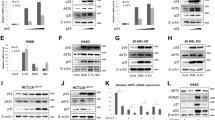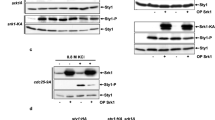Abstract
Faithful and efficient transmission of biological signals through mitogen-activated protein kinase (MAPK) pathways requires engagement of highly regulated cellular machinery in response to diverse environmental cues. Here, we report a novel mechanism controlling signal relay between two MAP3Ks, apoptosis signal-regulating kinase (ASK) 1 and ASK2. We show that ASK2 specifically interacts with 14-3-3 proteins through phosphorylated S964. Although a 14-3-3-binding defective mutant of ASK1 (S967A) has no effect on the ASK2/14-3-3 interaction, both overexpression of the analogous ASK2 (S964A) mutant and knockdown of ASK2 dramatically reduced the amount of ASK1 complexed with 14-3-3. These data suggest a dominant role of ASK2 in 14-3-3 control of ASK1 function. Indeed, ASK2 S964A-induced dissociation of 14-3-3 from ASK1 correlated with enhanced phosphorylation of ASK1 at T838 and increased c-Jun N-terminal kinase phosphorylation, the two biological readouts of ASK1 activation. Our results suggest a model in which upstream signals couple ASK2 S964 phosphorylation to the ASK1 signalosome through dual engagement of 14-3-3.
This is a preview of subscription content, access via your institution
Access options
Subscribe to this journal
Receive 50 print issues and online access
$259.00 per year
only $5.18 per issue
Buy this article
- Purchase on Springer Link
- Instant access to full article PDF
Prices may be subject to local taxes which are calculated during checkout





Similar content being viewed by others
References
Aitken A . (2006). 14-3-3 proteins: a historic overview. Semin Cancer Biol 16: 162–172.
Chang HY, Nishitoh H, Yang X, Ichijo H, Baltimore D . (1998). Activation of apoptosis signal-regulating kinase 1 (ASK1) by the adapter protein Daxx. Science 281: 1860–1863.
Cohen P, Klumpp S, Schelling DL . (1989). An improved procedure for identifying and quantitating protein phosphatases in mammalian tissues. FEBS Lett 250: 596–600.
Fu H, Subramanian RR, Masters SC . (2000). 14-3-3 proteins: structure, function, and regulation. Annu Rev Pharmacol Toxicol 40: 617–647.
Gardino AK, Smerdon SJ, Yaffe MB . (2006). Structural determinants of 14-3-3 binding specificities and regulation of subcellular localization of 14-3-3-ligand complexes: a comparison of the X-ray crystal structures of all human 14-3-3 isoforms. Semin Cancer Biol 16: 173–182.
Goldman EH, Chen L, Fu H . (2004). Activation of apoptosis signal-regulating kinase 1 by reactive oxygen species through dephosphorylation at serine 967 and 14-3-3 dissociation. J Biol Chem 279: 10442–10449.
Ichijo H, Nishida E, Irie K, ten Dijke P, Saitoh M, Moriguchi T et al. (1997). Induction of apoptosis by ASK1, a mammalian MAPKKK that activates SAPK/JNK and p38 signaling pathways. Science 275: 90–94.
Imoto K, Kukidome D, Nishikawa T, Matsuhisa T, Sonoda K, Fujisawa K et al. (2006). Impact of mitochondrial reactive oxygen species and apoptosis signal-regulating kinase 1 on insulin signaling. Diabetes 55: 1197–1204.
Iriyama T, Takeda K, Nakamura H, Morimoto Y, Kuroiwa T, Mizukami J et al. (2009). ASK1 and ASK2 differentially regulate the counteracting roles of apoptosis and inflammation in tumorigenesis. Embo J 28: 843–853.
Izumiya Y, Kim S, Izumi Y, Yoshida K, Yoshiyama M, Matsuzawa A et al. (2003). Apoptosis signal-regulating kinase 1 plays a pivotal role in angiotensin II-induced cardiac hypertrophy and remodeling. Circ Res 93: 874–883.
Kyriakis JM, Avruch J . (2001). Mammalian mitogen-activated protein kinase signal transduction pathways activated by stress and inflammation. Physiol Rev 81: 807–869.
Mackintosh C . (2004). Dynamic interactions between 14-3-3 proteins and phosphoproteins regulate diverse cellular processes. Biochem J 381: 329–342.
Matsuzawa A, Saegusa K, Noguchi T, Sadamitsu C, Nishitoh H, Nagai S et al. (2005). ROS-dependent activation of the TRAF6-ASK1-p38 pathway is selectively required for TLR4-mediated innate immunity. Nat Immunol 6: 587–592.
Min W, Lin Y, Tang S, Yu L, Zhang H, Wan T et al. (2008). AIP1 recruits phosphatase PP2A to ASK1 in tumor necrosis factor-induced ASK1-JNK activation. Circ Res 102: 840–848.
Morrison DK . (2009). The 14-3-3 proteins: integrators of diverse signaling cues that impact cell fate and cancer development. Trends Cell Biol 19: 16–23.
Muslin AJ, Lau JM . (2005). Differential functions of 14-3-3 isoforms in vertebrate development. Curr Top Dev Biol 65: 211–228.
Muslin AJ, Tanner JW, Allen PM, Shaw AS . (1996). Interaction of 14-3-3 with signaling proteins is mediated by the recognition of phosphoserine. Cell 84: 889–897.
Nishitoh H, Matsuzawa A, Tobiume K, Saegusa K, Takeda K, Inoue K et al. (2002). ASK1 is essential for endoplasmic reticulum stress-induced neuronal cell death triggered by expanded polyglutamine repeats. Genes Dev 16: 1345–1355.
Osaka N, Takahashi T, Murakami S, Matsuzawa A, Noguchi T, Fujiwara T et al. (2007). ASK1-dependent recruitment and activation of macrophages induce hair growth in skin wounds. J Cell Biol 176: 903–909.
Petosa C, Masters SC, Bankston LA, Pohl J, Wang B, Fu H et al. (1998). 14-3-3zeta binds a phosphorylated Raf peptide and an unphosphorylated peptide via its conserved amphipathic groove. J Biol Chem 273: 16305–16310.
Subramanian RR, Zhang H, Wang H, Ichijo H, Miyashita T, Fu H . (2004). Interaction of apoptosis signal-regulating kinase 1 with isoforms of 14-3-3 proteins. Exp Cell Res 294: 581–591.
Takeda K, Noguchi T, Naguro I, Ichijo H . (2008). Apoptosis signal-regulating kinase 1 in stress and immune response. Annu Rev Pharmacol Toxicol 48: 199–225.
Takeda K, Shimozono R, Noguchi T, Umeda T, Morimoto Y, Naguro I et al. (2007). Apoptosis signal-regulating kinase (ASK) 2 functions as a mitogen-activated protein kinase kinase kinase in a heteromeric complex with ASK1. J Biol Chem 282: 7522–7531.
Thorson JA, Yu LW, Hsu AL, Shih NY, Graves PR, Tanner JW et al. (1998). 14-3-3 proteins are required for maintenance of Raf-1 phosphorylation and kinase activity. Mol Cell Biol 18: 5229–5238.
Wang B, Yang H, Liu YC, Jelinek T, Zhang L, Ruoslahti E et al. (1999). Isolation of high-affinity peptide antagonists of 14-3-3 proteins by phage display. Biochemistry 38: 12499–12504.
Wang H, Zhang L, Liddington R, Fu H . (1998a). Mutations in the hydrophobic surface of an amphipathic groove of 14-3-3zeta disrupt its interaction with Raf-1 kinase. J Biol Chem 273: 16297–16304.
Wang XS, Diener K, Jannuzzi D, Trollinger D, Tan TH, Lichenstein H et al. (1996). Molecular cloning and characterization of a novel protein kinase with a catalytic domain homologous to mitogen-activated protein kinase kinase kinase. J Biol Chem 271: 31607–31611.
Wang XS, Diener K, Tan TH, Yao Z . (1998b). MAPKKK6, a novel mitogen-activated protein kinase kinase kinase, that associates with MAPKKK5. Biochem Biophys Res Commun 253: 33–37.
Winter-Vann AM, Johnson GL . (2007). Integrated activation of MAP3Ks balances cell fate in response to stress. J Cell Biochem 102: 848–858.
Yaffe MB . (2002). How do 14-3-3 proteins work?—Gatekeeper phosphorylation and the molecular anvil hypothesis. FEBS Lett 513: 53–57.
Yaffe MB, Rittinger K, Volinia S, Caron PR, Aitken A, Leffers H et al. (1997). The structural basis for 14-3-3: phosphopeptide binding specificity. Cell 91: 961–971.
Zhang L, Chen J, Fu H . (1999a). Suppression of apoptosis signal-regulating kinase 1-induced cell death by 14-3-3 proteins. Proc Natl Acad Sci USA 96: 8511–8515.
Zhang L, Wang H, Masters SC, Wang B, Barbieri JT, Fu H . (1999b). Residues of 14-3-3 zeta required for activation of exoenzyme S of Pseudomonas aeruginosa. Biochemistry 38: 12159–12164.
Zhang R, He X, Liu W, Lu M, Hsieh JT, Min W . (2003). AIP1 mediates TNF-alpha-induced ASK1 activation by facilitating dissociation of ASK1 from its inhibitor 14-3-3. J Clin Invest 111: 1933–1943.
Acknowledgements
We thank the past and present members of the Fu laboratory for many stimulating discussions, as well as Zhengbin Yao for helpful suggestions. This work was supported by a National Cancer Institute National Research Service Award Grant 5F31CA117057 and a National Science Foundation Facilitating Academic Careers in Engineering and Science Fellowship 0450303 (I6660663) to LMC, an NIH Pharmacological Sciences Training Grant T32 GM008602 to MCP, NIH Grant RO1GM53165 and Emory URC grant to HF, and NIH/NCI Grant PO1CA116676 and USAMRMC05075002 to FRK and HF. HF is a Georgia Research Alliance Distinguished Investigator, and FRK and HF are Georgia Cancer Coalition Distinguished Cancer Scholars.
Author information
Authors and Affiliations
Corresponding author
Additional information
Supplementary Information accompanies the paper on the Oncogene website (http://www.nature.com/onc)
Rights and permissions
About this article
Cite this article
Cockrell, L., Puckett, M., Goldman, E. et al. Dual engagement of 14-3-3 proteins controls signal relay from ASK2 to the ASK1 signalosome. Oncogene 29, 822–830 (2010). https://doi.org/10.1038/onc.2009.382
Received:
Revised:
Accepted:
Published:
Issue Date:
DOI: https://doi.org/10.1038/onc.2009.382
Keywords
This article is cited by
-
DAB2IP predicts treatment response and prognosis of ESCC patients and modulates its radiosensitivity through enhancing IR-induced activation of the ASK1-JNK pathway
Cancer Cell International (2022)
-
Intrinsic disorder in proteins associated with oxidative stress-induced JNK signaling
Cellular and Molecular Life Sciences (2022)
-
IRE1α RIDD activity induced under ER stress drives neuronal death by the degradation of 14-3-3 θ mRNA in cortical neurons during glucose deprivation
Cell Death Discovery (2021)
-
The dynamic and stress-adaptive signaling hub of 14-3-3: emerging mechanisms of regulation and context-dependent protein–protein interactions
Oncogene (2018)
-
Elevated serum 14-3-3η protein may be helpful for diagnosis of early rheumatoid arthritis associated with secondary osteoporosis in Chinese population
Clinical Rheumatology (2017)



